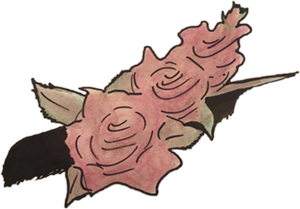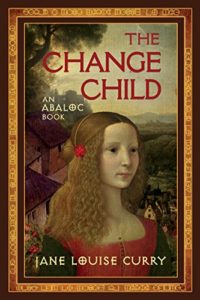
“When we read or enact or talk about the circle of life it depends upon our own stage in our journey, what aspects of the circle are foregrounded and helpful to our continuing quest. One young protagonist of a fantasy by Jane Louise Curry shows us how a quest in the form of a journey away from home is not only a means of running away; it’s a way to make a difference.”
“Eilian makes her third step towards Faery when she journeys into the forest under the guidance of Goronwy, the boy who has always seemed quite ordinary, but now turns out to be one of the ‘elvish folk’ after all.”
Abstract
“We shall not cease from exploration
And the end of all our exploring
Will be to arrive where we started
And know the place for the first time. (Eliot, 1943, p18.)
When we set out on a quest, where do we think we are going? Do we know what we are looking for? Do we even realise that we are questing? Do we expect to return?
Key words: coming of age. Faery. Quests. Journeys Home.

The protagonists of myth and legend, folktales and twentieth century fantasy fiction seek, more or less consciously, a variety of outcomes. Gilgamesh, because he “was afraid of death”, went to seek “Utnapishtim the Faraway” (Sandar, 1964, p. 94) in hope of restoring to life his friend Enkidu. This proved impossible, and to this extent the quest failed; but Gilgamesh had learned that “death comes as the end.” (Christie, 1945) Learning this, and learning to live in the light of that knowledge, was his triumph. Beowulf (Klaeber, 1950) went in search of fame and honour, and in his victory over Grendel and Grendel’s mother restored light and hope to Heorot; another triumph. But when the dragon came, it was death that had the last word, just as in Mesopotamia and Ancient Egypt.
Yet the goal of the quest is more than a life-long battle against the onset of death. The quest itself is the life we lead. Does this onward life-journey mean that Eliot’s words quoted above are wrong? Can we never go back to our beginnings and know them more fully? Is it true that; “You can’t go home”? Certainly Frodo Baggins (Tolkien, 1966, p. 309) was unable to do that, too damaged by the horrors of his quest experience to settle down at home.
 When we read or enact or talk about the circle of life it depends upon our own stage in our journey, what aspects of the circle are foregrounded and helpful to our continuing quest. One young protagonist of a fantasy by Jane Louise Curry shows us how a quest in the form of a journey away from home is not only a means of running away; it’s a way to make a difference. Eilian (Curry, 1970) does not leave her home “because [she is] afraid of death” nor even by her own choice. But what she learns on her quest journey shows her the possibilities of life. And she eventually goes “home” to tackle the job of living; to a starting place understood “for the first time.” (Curry, 1970)
When we read or enact or talk about the circle of life it depends upon our own stage in our journey, what aspects of the circle are foregrounded and helpful to our continuing quest. One young protagonist of a fantasy by Jane Louise Curry shows us how a quest in the form of a journey away from home is not only a means of running away; it’s a way to make a difference. Eilian (Curry, 1970) does not leave her home “because [she is] afraid of death” nor even by her own choice. But what she learns on her quest journey shows her the possibilities of life. And she eventually goes “home” to tackle the job of living; to a starting place understood “for the first time.” (Curry, 1970)
Many of Curry’s novels bring together Amerindian and Celtic mythology, archaeology, history and legend to build a complex mythical history that dates from before the beginning of the current age up to the late twentieth century. Her stories always involve magic, many of them involve time-shift, and in most of them “elvish folk” are featured, either as main characters in the story or as influences in the background. Through all of them, too, run the themes of selfhood and identity, bound up with related ideas of belonging and commitment. Eilian’s quest in The Change Child (Curry, 1970) can be labelled a “coming-of-age” story; but in using that label we should remember that guidance through adolescence was once a solemn community ritual, enacting the tradition and lore of the folk. The ritual journey into the wilderness or around a sacred precinct led back home; home might then have seemed a different place but the difference lay, and still lies today, within the individual whose role has changed and whose insights have moved beyond those of childhood. Reflection on this reveals why Curry’s novel is called “The Change Child” and not “The Changeling.” Some people believe Eilian to be a changeling, an unwanted faery child exchanged for her parent’s true daughter. But the story unfolds by revealing that Eilian is a child who is changing; changing into an adolescent, on the way to adulthood.
In Curry’s stories, hauntingly beautiful evocations of the otherworld of Celtic legend are employed to show how experiences with that otherworld stand in her works, as they did in the ancient tales, for the experiences of the deeper levels of the mind. Faery is employed as a metaphor for the underlying states both of individual consciousness and of the social structure. This skilled dual usage is revealed very clearly in The Change Child.
Set in Wales at the turn of the sixteenth and seventeenth centuries, this tale uses the metaphor of the otherworld encounter to point up a time of growth in consciousness and self-awareness in Eilian, the change-child of the title. Slightly disabled in one foot, red-headed, and given to the making of songs and poems, she is regarded with suspicion by neighbours as a probable changeling. Since her own mother is exasperated by her daughter, and seems only half-joking in her own application of the term “changeling” to Eilian, the child feels rejected and in the wrong. She has comfort from her father’s love and her grandmother’s care; but there is still bitterness to cope with. Even her father says; “…it’s foolishness for a girl to wish to be a poet at all, that only a man can be a bard and compete for prizes at the Eisteddfodau…” (Curry, 1970 p35) She cherishes a compensatory self-image that involves some idea that she might actually be special, might have faery blood in her, even though she explicitly states, “I am no changeling!” (Curry, 1970, p. 42) Bettelheim points out that this is one of the consolations that children adopt for themselves and find in faery-tale;
The feeling of inferiority is defensively turned into a feeling of superiority.
The pre-pubertal or adolescent child may say to himself, “I do not compete with my parents, I am already better than they are; it’s they who are competing with me.” ……………. Every child at some time wishes that he were a prince or princess – and at times, in his unconscious, the child believes he is one, only temporarily degraded by circumstances. (Bettelheim, 978, pp 204-205.)
Eilian’s circumstances change three times during the novel, and although the cause of these changes, in terms of the “real” world, is trouble between her father and the Rastall family over the inheritance of a family house, Plaseirian, her three awakenings constitute a quest experience for Eilian. She is forced in the course of this triple testing to learn to value others and to give weight to their needs; to accept responsibility for her actions; and to be reconciled to the limitations and the potential of her own nature. She has to make a choice of allegiance, a commitment. While the outer problem of the inheritance is being worked out in plots and lawsuits, Eilian’s growth is being worked out in a visit to Faery which, in the terms of the novel, “really” happens, but has much in common with the traditional tales in which every action is expressive of some psychological trait or condition of the protagonist. Both levels come together at the end of the book to reconcile Eilian with her mother, whose own attitude has become gentler as a result of her improved fortunes; so that their new home, Plaseirian, is a true home where the family can flourish.
Eilian’s first shock of awareness comes when she is on her way back home after a year in service. So her story begins with a journey home; but this journey is not toward the end of a quest; it is the beginning. At the annual Caernarvon Fair, not only do several people make changeling comments within her hearing; she is also accosted by Simon Rastall, son of an English lord, who addresses her as his “little bird-bride” and seems to have intentions of marrying her. Although his father calls him away, Eilian is left bewildered and afraid all through her long journey home to Llwyn Cerddin, her family’s cottage. Even arrival home adds to her confusion, as in the course of a year her father has built extensions and improvements that make home seem strange. Once inside she learns that this is linked with Rastall, and that the family is in the midst of lawsuits over the inheritance of the superior farm and house at Plaseirian, against the Rastall family. This is her first insight into the heavy-handed local rule of the English over Wales. At this broadest level of community, her people are all misfits.
Her father is due to travel to Ludlow on this legal business, and Eilian is sent to stay with her grandmother and her band of followers, who are known as the Red Fairies. They live at the edge of the forest and declare themselves free of the constrictions of settled folk. She is “enchanted” by them in the everyday sense of being very much in love with the idea of them, and she makes a kind of commitment to them in her heart on first meeting.
There were laughs and greetings and kisses, and in the light of the lanterns their hair shone gold and their eyes gleamed silver. Eilian tightened her arms around her uncle’s waist until he could feel her heart pounding from excitement. “Maybe I”ll never go home,” she thought. “Maybe, maybe this is the true homecoming.” Mam and Dad seemed dim shadows in a heavier world. (Curry, 1970, p. 251.)
This romantic hope is knocked flat by Eilian’s eventual discovery that the Red Fairies are in fact robbers; that her beloved uncle Emrys is weak and under his mother’s thumb; and that her dear grandmother is plotting to sell her to Simon Rastall against her father’s wishes. Her second step towards faery/awareness is as painful as her first. Adopting the Red Faery identity would be no answer to her problems; they are flawed, ambivalent, ordinary individuals, the normal mixture of good and bad. From the viewpoint of the “respectable” community, the Red faeries themselves are misfits. Having brought her to this point, the story now takes her into Faery, to find herself; to see the complexities of the truth about herself, as she has seen it about Emrys and Mamgu and the others.
Eilian makes her third step towards Faery when she journeys into the forest under the guidance of Goronwy, the boy who has always seemed quite ordinary, but now turns out to be one of the “elvish folk” after all. On the everyday level the forest functions as a refuge for the injured Emrys, who is in danger of arrest if he does not go to ground. On the psychological level, the forest is fulfilling its traditional role as a symbol of wandering in the unconscious, exploring the self, often at risk – expressed as the danger of going mad – but with the hope of coming safely through. Two traditional examples of this are the mediaeval tale of Sir Orfeo, (Sands, 1966. pp. 185-200.) who wandered bereft of reason until his music healed him and he was reconciled to his wife Herodis; and Malory’s Lancelot who ran mad for two years in the forest; a token of his inability to cope with the pressures of Guenever’s possessiveness. (Malory, 1954.) In both these tales the fact of being lost in the forest stands for wandering in the inner word of the unconscious self. Eilian is not wholly lost, but guided by the care – and criticism – of Goronwy. She passes through the forest with him, is aware of his sense that she is letting herself down by her self-absorbed attitude, and gradually comes to realisation of the importance and uniqueness of other selves; “I only let him be Uncle, she thought, not Emrys. …… But now he was his own ……” (Curry, 1970, p. 99.)
In the next encounter, with the Tylweth Teg, Eilian finally meets the truth about herself. She learns, ironically enough, that she is indeed of faery blood; but the learning is an ambivalence of bitterness and pleasure. For on the personal level, she sees that there is a sense in which this makes no difference. Her growing conviction, for example, that she may make a good singer but has not as much skill as a poet as she had hoped, is not affected either way by this. And painfully, on the wider level, her coming functions as the fulfilment for the Tylweth Teg of a prophecy that they must leave Middle-Earth for the faery kingdoms over sea. She fits into a role prepared for her over ages; but her being a “fit” in this pattern of relationships has brought mixed results: joy to Goronwy, who loves her; pain to the Tylweth Teg, who lose their ancient home; and to herself, the realisation of her need to make the effort to accept herself and learn to accept others. Pre-eminently, to learn that no-one is ever a complete “fit” in any situation. There is no side-stepping the quest for self-acceptance, however colourful one’s ancestry or multifarious one’s talents. And so Eilian’s act of commitment is an act of commitment to herself, to life. As the old heroes learned to mobilise their inner strengths to defeat evil, Eilian is taught by the Lady Wintida that her answers are also within:
Eilian was muddled. “Change is not good then? ‘she ventured doubtfully.
“On the contrary, child. All that is good comes through it. But it is no sudden shift played on you, for what is growth but change and transformation? To fear it is to invite decay, but to live in hope it be imposed upon you by some kindly fate is to live a fool.”
“I do not understand. Am I so foolish?” No sooner had she said it than a thought brushed past Eilian of the aching sameness, the dreaming-of-when–things–would–be–differentness, of so many of her days.
The lady smiled. “Only in thinking we can give you love and peace if you have not tended the seeds of these things in your own heart. (Curry, 1990, pp. 111-112.)
The last pages of the book confirm that Eilian’s journey has been a quest for the herself and a process of integration; her father reflects, when she has returned to their new house; “It is the real child’s come home.” (Curry, 1970, p. 131.) And Curry closes the novel with an age-old symbol of psychological and spiritual stability; the symbol of the tree.
“and I have bought a cherry tree,” said Eilian, “which I must plant tomorrow.” (Curry, 1970, p. 139.)
References
Bettelheim, B. (1978.) The uses of enchantment: the meaning and importance of fairy-tales. Harmondsworth, England: Penguin Books.
Christie, Agatha. (1944.) Death comes as the end. London, England: Collins.
Curry, J. L[1]. (1970.) The change child. London, England: Dobson Books Ltd.
Eliot, T. S. (1934.) Four Quartets. London, England: Faber and Faber.
Klaeber, F. (ed.) (1950.) Beowulf. Boston: D.C. Heath & Co.
Malory, T. Works. (1954.) London, England: Oxford University Press.
Sandar, N. K. (1964.) The epic of Gilgamesh. Harmondsworth, England: Penguin Books.
Sir Orfeo. in Sands, D. B. (ed.) (1966.) Middle English verse romances. Chicago: Holt, Rinehart and Winston, Inc.
Tolkien J. R. R. (1966.) The return of the king. (2nd ed.) London, England: George Allen and Unwin.
Endnotes
[1] Jane Louise Curry also publishes as Jane Curry. For her other works visit: https://www.goodreads.com/author/show/145166.Jane_Louise_Curry
 SUE BRIDGWATER was born in Plymouth in 1948 and after 20 years in Hackney, East London has now retired home to Devon. She has generally earned her living as a librarian, and has been writing seriously since the early 1980s.
SUE BRIDGWATER was born in Plymouth in 1948 and after 20 years in Hackney, East London has now retired home to Devon. She has generally earned her living as a librarian, and has been writing seriously since the early 1980s.
Sue read English at Bedford College, London, graduating in 1970. Her M. Phil. in Children’s Fantasy Fiction was done externally during her children’s pre-school years, and was awarded in 1984. She was a Tutor in Literature and Creative Writing from 1982-96 for the Workers’ Educational Association (London District) and the Centre for Extra-Mural Studies, University of London (now a part of Birkbeck College, University of London). Sue has completed a Birkbeck College Certificate in Creative Writing, September 2002-June 2004, developing fiction techniques and skills. Her main interest is in Fantasy and Science Fiction. She is currently working on non-fiction in the field of mythopoeic studies and on the fourth novel in the Skorn series.